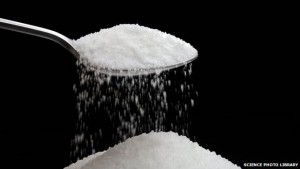UK Guidelines on Reducing Sugar in Food Published For Industry

Public Health England (PHE) has published the technical guidelines setting out the approaches the food industry can take to reduce the amount of sugar children consume through the everyday foods that contribute the most to intakes. The reduction programme could see 200,000 tonnes of sugar removed from the UK market per year by 2020.
The guidelines include the recommended sugar limits for 9 food groups including biscuits, breakfast cereals and yogurt. Also published is the 2015 baseline. The 9 food categories in the programme are:
* breakfast cereals
* yogurts
* biscuits
* cakes
* morning goods like croissants
* puddings
* ice creams, lollies and sorbets
* confectionery (chocolate and sweet)
* sweet spreads, which is sub-categorised into:
* chocolate spread
* peanut butter
* dessert toppings and sauces
* fruit spreads
Sub-categories have been introduced due to the wide range of different products included in the sweet spreads category. Encouraging the industry to innovate to lower children’s sugar intakes means the programme will be good for health and good for business.
One of the main commitments in the Government’s Childhood obesity: a plan for action was to reduce the amount of sugar contained in food. The challenge is to reduce sugar by 5% by August 2017 and overall by 20% by 2020.
The 3 approaches the food industry can take to reduce sugar are:
* reformulating products to lower the levels of sugar present
* reducing the portion size, and/or the number of calories in single-serve products
* shifting consumer purchasing towards lower or no added sugar products.
 PHE will judge the success of the sugar reduction programme by measuring the net amount of sugar removed from key food categories. The principles are to encourage the industry to go further and faster in sugar reduction in order to improve health outcomes, but also to give it flexibility in how it meets the Government’s challenge
PHE will judge the success of the sugar reduction programme by measuring the net amount of sugar removed from key food categories. The principles are to encourage the industry to go further and faster in sugar reduction in order to improve health outcomes, but also to give it flexibility in how it meets the Government’s challenge
Duncan Selbie, Chief Executive of PHE, says: “The UK has one of the most innovative food sectors in the world and it’s in everyone’s best interests to ensure it remains a dynamic and thriving sector of our economy. The scale of our ambition to reduce sugar is unrivalled anywhere in the world, which means the UK food industry has a unique opportunity to innovate and show the rest of the world how it can be done. I believe reducing sugar in the nation’s diet will be good for health and ultimately good for UK food business.”
Duncan Selbie adds: “We can’t duck the fact a third of children are leaving primary school overweight or obese and obesity generally is having a profound effect, not just on the costs for the health service, but on the overall health of the nation. Our economy is affected as obesity can lead to long term health problems that result in time off work.”
PHE’s Chief Nutritionist, Dr Alison Tedstone says: “Overweight and obese children are likely to carry this health problem into adulthood, increasing their risk of Type 2 diabetes, heart disease and some cancers. Levels of obesity are higher in children from deprived backgrounds. Tackling the amount of sugar we eat is not just a healthy thing to do, but an issue of inequality for many families. If businesses achieve these guidelines, 200,000 tonnes of sugar could be removed from the UK market per year by 2020.”
The PHE guidance confirms:
- guidelines for the sugar levels of food are set for the 9 categories of products providing sugar to children’s diets (up to the age of 18 years)
- soft drinks are covered by the industry sugar levy
- all types of sugars are in scope for these categories, except the naturally occurring milk sugars in yogurt and some sugar in plain whole dried fruit in breakfast cereals
- 2015 baseline levels of sugar in foods have been established using Kantar Worldpanel and nutrition information for manufacturers and retailers, and NPD Crest information for the out of home sector and publically available nutritional information for that sector
- some data have also been provided by industry including some out of home businesses
- the 20% total sugar reduction target has been set based on 2015 average sugar levels across the 9 categories, known as the sales weighted average
- the sales weighted average is calculated by weighting the contribution of individual products by their volume sales – a high-selling, high-sugar product will increase the sales weighted average and a high-selling, low-sugar product will reduce the sales weighted average
- this sets out the clear goal for a sales weighted average for sugar per 100g for each category to be achieved by 2020 and provides a figure against which progress can be monitored
- sweeteners that have been approved through European Food Safety Authority’s processes are a safe and acceptable alternative to using sugar.

































